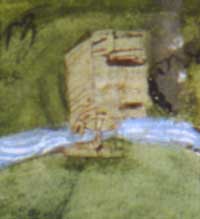 |
 |
 |
 |
 |
 |
 |
|
|
Water The spot was by a powerful stream called
the Rye in a broad valley Water was an important source of fish, which formed a significant part of the monastic diet. It was therefore vital that Cistercian communities secured rights to fish and to fisheries, and to build fish ponds, known as stews, both within and outside of the monastic precinct. In fact, Fountains has been described as a pioneer in the development of fish farming and the . Read more about Fountains' fisheries Water management was vital to the survival and self-sufficiency of the monastic community, and the Cistercians invariably settled on sites where they had access to a natural source of water. For example, Rievaulx, in N. Yorkshire, was built by the River Rye, from which the community took its name; Roche, in S. Yorkshire, was situated in the valley of the Maltby Beck. Kirkstall Abbey, on the outskirts of Leeds, was bounded to the south by the River Aire; Fountains was located in the valley of the River Skell, and surrounded by springs. Each of these communities could channel this water to supply the monastery with water for drinking, cooking and washing, for liturgical purposes, to power mills and also, of course, to remove waste from the site. Whilst an inadequate water supply might cause a community to disband or relocate, and was a main factor affecting the removal of the Fors community to Jervaulx in 1156, dampness and flooding could be equally problematic, and caused considerable difficulties for the monks of Meaux and Sawley. Water management was as much about removing water where it was not required and preventing excess. Read more about water management at Fountains |

